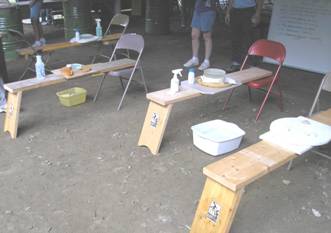

Stellafane sits on roughly 90 acres of land that is known as the mecca for Amateur Telescope Makers. Legions of amateur telescope makers travel to Breezy Hill in Springfield Vermont. They come there to discuss the design, manufacture and the ins-and-outs of telescope making. Some people refer to it as the “secrets of the ATM’s.” The person most credited with amateur telescope making and sometimes referred to as the “godfather” is a gentleman named Russel Porter.
Porter trained as an architect in Boston, explored the arctic with Robert Peary and Frederick Cook and returned to Springfield to work as an optical engineer at Jones & Lamson Machine Co. In 1929 Porter moved to California to direct the building of the 200-inch Hale Telescope at Palomar Observatory. In 1920 Porter conducted a class in telescope making at Jones & Lamson Machine Co. 15 machinists and toolmakers and a stenographer, the lone female, signed up for the class. Those students along with Porter and James Hartness President of the Jones & Lamson Machine Co. formed the core of the original Springfield club.

We start our tour of Stellafane in the Pavilion. This picture shows the grinding stands that are used by the students to learn how to grind a mirror.
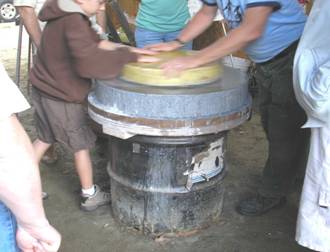
Under the leadership of one of the instructors, this student spent some time grinding a 27 inch mirror. The yellow disk on top is the tool, the mirror is on the bottom.
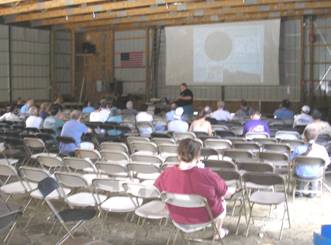
A lecture on fine grinding and polishing techniques was conducted for beginning ATMs in the Flanders Pavilion.
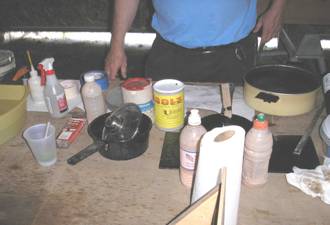
Shown here are the materials used in the Pitch Lap making demonstration.
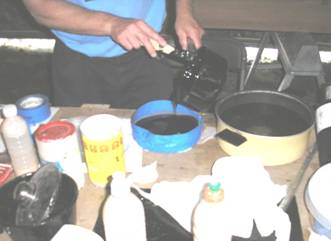
The instructor discusses the melting of the pitch as he pours the pitch into the taped dam around the tool. This will become the polishing lap.
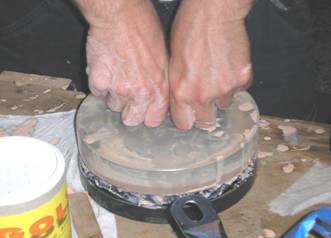
The pitch lap was formed using a mirror on top technique. The pink solution is cerium oxide.
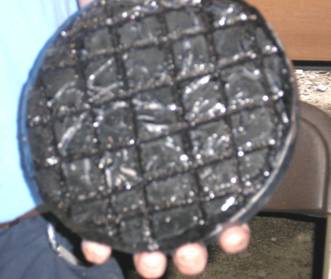
Cerium oxide is used for polishing and to keep the mirror from sticking to the pitch. The pitch lap will have the same form as the mirror. The picture shows a completed pitch lap with the groves cut in. There are many techniques for grooving a pitch lap. The instructor used a single edge razor blade to cut the groves and he made it look easy. Some of the instructors are professional opticians and can answer a lot of your questions.
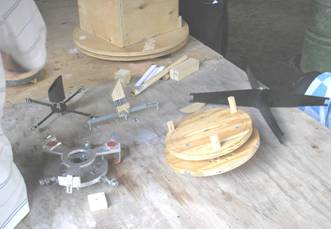
Shown here are some commercial parts and some homemade parts used for telescope making.
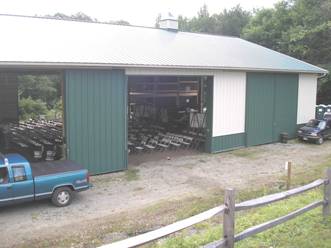
The Flanders Pavilion is used for the ATM demonstrations, technical talks and many other events. The building can be completely closed during thunder storms, so you can stay dry.
Over the years the Springfield Telescope makers have changed Stellafane to be more family orientated. They have astronomy activities, Friday and Saturday for children ages 5-12 in the McGregor Observatory classroom. There are other types of talks, such as; “Using a Telescope with your Child,” and “Discover and Enjoy the Sky.”
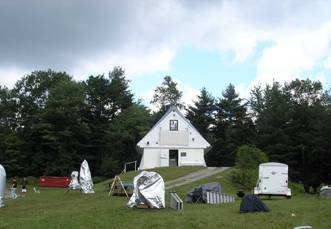
The McGregor Observatory is a big roll off roof observatory with a classroom. Surrounded by an observing area with a couple of big dobs that add to the adventure. The observatory houses the Thirteen-inch Schupmann Telescope. Below is an illustration of the telescopes design.
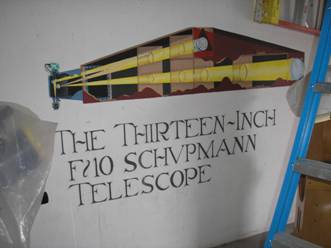
Amateur telescope makers from all over North America, Europe and some times Australia come to Stellafane with telescopes they have built and enter them in the Optical competition or Mechanical competition.
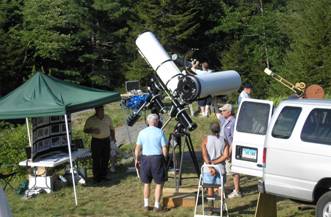
One entry that drew a lot of interest was the two 16 inch F/16 cassegrain telescopes that were hand made by two members of the Springfield Telescope Makers. Look at the van, then look at the size of the telescopes. Both telescopes are on equatorial mounts. They made the 16” mirror and secondary for the optical system and used inferometry to show the optical quality. The machining was first class. They used raw stock and machined it into finished parts; optical tube assembly, equatorial mount, shafts, gears etc.
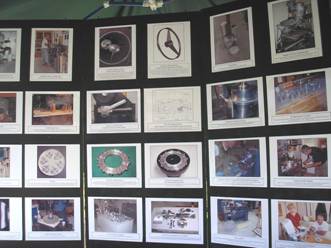
This tells it all, a photographic display booth of 8x10 pictures shows the manufacturing and construction of the telescopes. The pictures describe the optical work as well as the machines used; Bridgeport mill and lathe just to name a few. These telescopes won awards in the optical and mechanical competition.
After looking at those two machined masterpieces my eye was attracted to this 12.5” F/5 telescope named “Captain Nemo’s Telescope.”
The telescope was built by Ross Sackett a member of the Memphis Astronomical Society. The telescope is based on the question; “If Jules Verne owned a Dobsonian telescope what would it look like.” This telescope is based on a design called “steampunk.” This definition is copied from his flyer; “Steampunk is a contemporary art movement that blends modern technology with Victorian aesthetics, yielding chimeric hybrids.” An example would be a laptop computer sheathed in rich mahogany, polished brass and gears and sprockets. This is clever and creative.
The telescope is made of Baltic birch plywood covered in African mahogany veneer, shaded stain and polyurethane finish. The truss pole design is made of six 7/8 OD polished copper tubes anchored by brass brackets. Another nice feature that was incorporated in the design, is a sliding bolt and four catches that are used to lock the mirrorbox to the rocker so the telescope can be rolled on the permanently attached wheels.
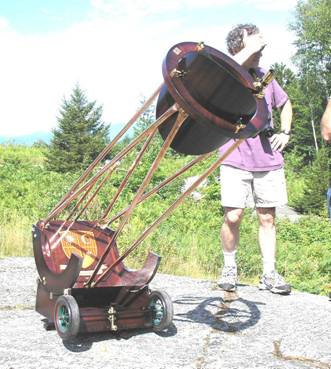
The next picture shows the upper cage and the offset 4 vane secondary holder. The vanes are cut in a “twining vine” pattern and are held in place with brass attachments. Then check out the brass finder scope.
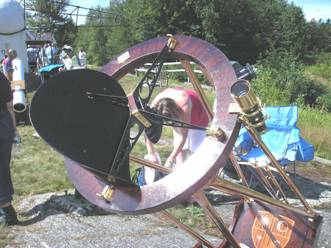
The next picture shows the gear and sprocket design that is a classic part of steampunk.
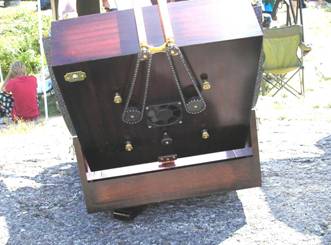
Look at the top of the rocker box and you will see two copper tubes that run halfway up the telescope that have brass knobs on the end. The bottom of the copper tubes are connected by gears to the roller chains and sprockets. You stand at the eyepiece and turn the brass knobs that will collimate the telescope, clever!
As I continue to look around Stellafane I have not forgotten about the club’s 17.5 Coulter mirror. The club is planning on building a new telescope and I have seen a couple of dobsonians built around a Coulter mirror. The first one is unusual because he flexes the mirror into a parabolic shape and uses a series of levers to correct for astigmatism in the mirror.
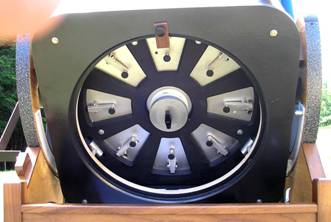
I’m not going to go into detail on how this telescope was built, what I want to show is the mirror cell design. The guy who built this titled his design; “17.5 Coulter with Flex Mirror and Astigmatic Corrector Plate.” The black spokes in the mirror cell are made out of one piece of 3/4 plywood. The silver colored background is a 1/2 aluminum plate. In the center you will see an aluminum disk with a black knob.
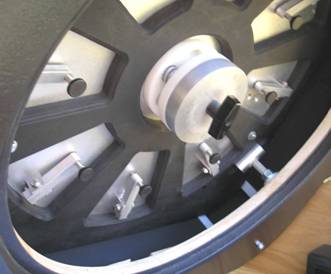
In the center of the mirror cell you can see a round disk of aluminum with a black knob on it. Look closely and you will see a spring between the disk and aluminum plate. You turn the knob and it flexes (stress) the mirror into a parabolic surface. This mirror cell is more complicated than it looks. The mirror actually sits in a pink insulation foam insert. The other part of the mirror cell design is used to cancel out the effects of astigmatism. Looking at the next picture gets to be complicated. You will see a close up of the levers that are located around the mirror cell. As you screw in the levers they push a pin in to another 1/4 inch aluminum plate that sits underneath the pink foam insert. Yes, this is getting complicated and I really need a technical drawing.
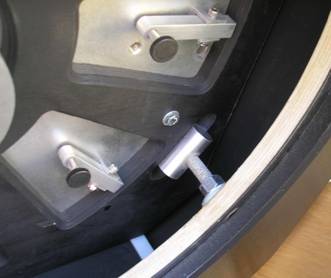
A lot of thought went into this type of design and I give the guy credit for figuring it out. Presently club members are working on building a new telescope using the club’s 17.5 Coulter mirror. The dobsonian below is a home made design and has a 17.5 Coulter mirror.
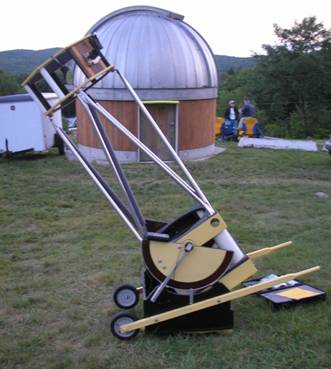
This dobsonian weights a total of 90 pounds and utilizes permanently mounted wheels to move it around. The owner invited me to pick it up with him, I did. The two of us easily moved this dob around. The truss tubes are stainless steel shower curtain rods. Notice the side bearing sits between the rocker box sections. That white tube that supports those sections is schedule 30 pvc (thinwall). He used four of them, one at each corner to cut down on rocker box weight.
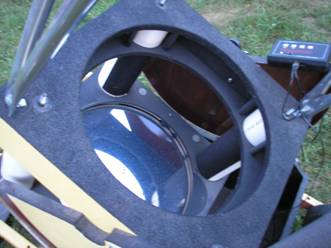
Here is an inside picture of the rocker box showing two pvc corners. The wood and pvc is held together with threaded rods through them (pvc) and nuts on the ends. The side bearings are attached to edges of the rocker sections.
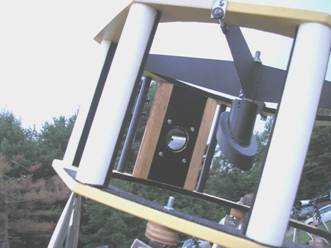
Shown here is the secondary cage. The white tubes are one inch diameter schedule 30 pvc tubes. They have threaded rods through them that are secured by nuts on the ends. Notice how the secondary mirror holder is attached to the spider vane.
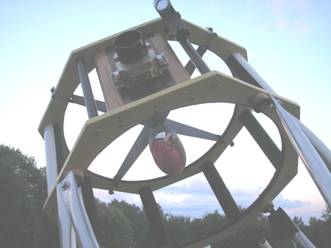
The top photo shows the secondary cage and focuser and finder scope.
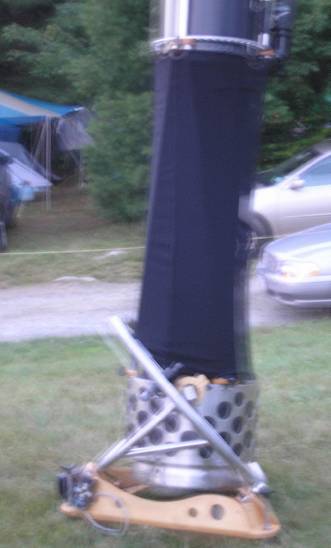
The next dobsonian is unique in its own right. I didn’t get to talk to the owner, but the rocker is made of a unique material. Sorry but this photo came out fuzzy.
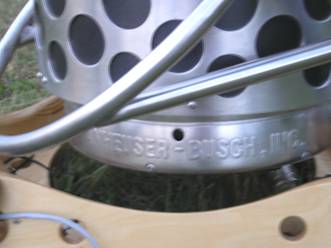
Now this new material is revealed. The holes cut in the keg where not cut with a hand held hole saw. Now we know what to do with those empty kegs students leave lying around. I continued to walk around Stellafane and look at the different telescopes but on occasion you walk into some type of home made gizmo. This happens at Stellafane.
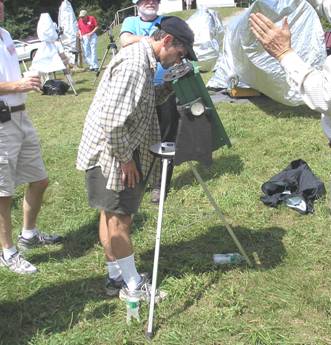
Now what do think this guy is looking at. If you guessed home made solar spectroscope, you guessed right. This spectroscope is made out of plywood and surplus lens from Surplus Shed and just used parts. I almost forgot one of the most important parts, the rubber band. Take a good look at the next picture.
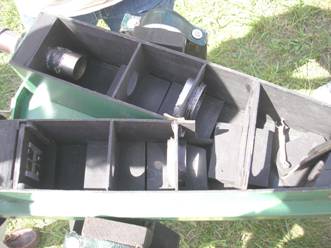
Notice the slit in the lower left hand of the picture. The spectrum is focused by the lenses on to the mirror at the right. As the mirror rotates part of the spectrum is magnified through the eyepiece and you see the absorption lines in a section of the spectrum. As you rotate the wheel on the side the mirror moves but is held in place by the tension from the rubber band.
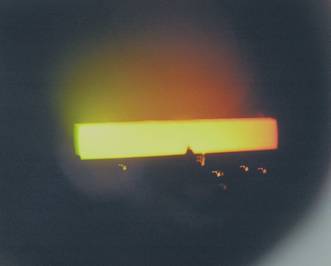
The absorption lines are there, the camera could not see them because of the glare. It works! This wraps up the article, if you want to learn more go to Stellafane.org or just google stellafane. From my house (canton) to Springfield, Vermont is about 745 miles one way or almost 1500 miles round trip. Round trip; Gas cost me about $300 plus and $40 for toll roads. If you haven’t been to Stellafane, then go there at least once, it’s worth it.
All photographs on this page were taken by Jack Brisbin.